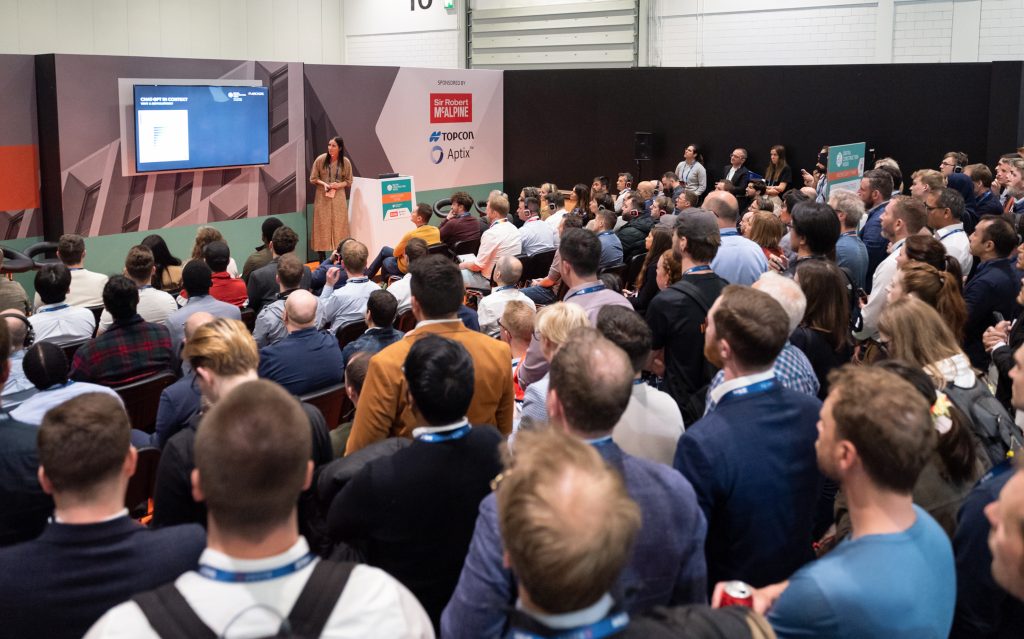Mar Zumaquero, Global Innovation Management Director at Arcadis, explores the role of generative artificial intelligence as a catalyst for enhancing efficiency and fostering innovation within the built environment.
Mar offers an optimistic view of the future that prioritises responsible deployment of this technology.
Why has generative AI caused such a revolution?
Generative artificial intelligence (AI) has caused a revolution in the built environment industry by bringing powerful capabilities to non-technical users. This technology, which allows for the creation of original content by learning from existing data, has revolutionised industries and started to transform the way businesses operate.
One of the key factors that contributed to this revolution was the release of ChatGPT, a conversational bot developed by OpenAI. This tool changed everything by lowering the entry barrier for all users, allowing those with minimal computing skills to use it without the need to understand complex AI concepts.
The impact of this revolution has been significant, with generative AI and foundation models changing the AI game, taking assistive technology to a new level, reducing application development time, and bringing powerful capabilities to non-technical users. This has the potential to be a major game-changer for businesses in the built environment provided they take the necessary steps to leverage the power of this technology across the enterprise.

Mar presenting her packed-out session at DCW 2023.
How can generative AI benefit the built environment industry?
The realms of architecture, engineering, construction and operations face many challenges in the 21st century, such as climate change, urbanisation, digitalisation and talent shortages. Generative AI can help professionals in this industry overcome some of these challenges by providing them with a powerful and versatile tool that can boost their knowledge, productivity, innovation and collaboration.
Tools like ChatGPT, Bing Copilot, Bard, Claude, and others based on Large Language Models and multimodal models can act as a knowledge assistant, helping users learn about new technologies and how to apply them to their projects. For example, a building designer can ask of the how to use immersive technologies, such as virtual reality or augmented reality, to enhance their design process and communicate their vision. Multimodal models can them help them create design options to put in front of clients and stakeholders.
Across Arcadis, we were quick to embrace generative AI, prioritising responsible deployment and providing Arcadians with secure tools that ensure we protect our clients’ data. Since June 2023, we have seen a large number of users leveraging Arcadis GPT – our internal tool – consistently. And we have taken steps to pilot third party tools like Microsoft Copilot to better understand the positive impact these will have across our business.
Our Global Innovation and Ecosystems team was quick to jump at the opportunity to leverage generative AI as an innovation copilot, helping us generate and validate problem spaces and potential solutions. This becomes a transformational change when it comes to gathering market insights or even running AI-fuelled customer interviews with synthetic personas. However, AI is used to augment our teams, not to replace them. And we make sure that innovations are not only AI-tested but also proven with real clients in the real world.
What are the risks and limitations of generative AI?
Given the lightning speed at which this technology is evolving, it is safe to assume that some of the current limitations will not be relevant much longer. It is, however, paramount to think about the potential risks when using this powerful technology.
One of the main concerns of generative AI is the potential for bias in the training data, which can lead to biased or discriminatory outcomes. As professionals, we have a responsibility to challenge this bias and ensure we are not reinforcing it. Another issue is the lack of control over the generated outputs, which can result in unethical or inappropriate content. Additionally, generative AI can be expensive to implement and can take a long time to train and deploy.
Despite these limitations, generative AI has the potential to revolutionise industries, including the built environment.
How can the industry prepare for the generative AI revolution?
Across all industries, but especially ours, given the slow pace of technology adoption in the past, we are seeing increasing efforts in getting ready for this new wave of artificial intelligence.
Organisations must prepare their workforce to adapt and be comfortable working alongside AI assistants and copilots. Prompting is not a skill of the future; it is needed now. The ability to input high quality prompts heavily influences the outputs produced by generative AI, hence a critical skill for all professionals across the industry.
Now more than ever, data is the new gold, and it is predicted that synthetic data, artificially generated rather than produced by real-world events, will help create more diverse and realistic datasets for different purposes and domains.
Organisations should not miss the opportunity to embrace this revolution and all of us as individuals have a responsibility to learn to work in this new world, through finding more efficient ways of working and through leveraging AI as a copilot to innovate future-proof solutions.
 By DCW Connect
By DCW Connect